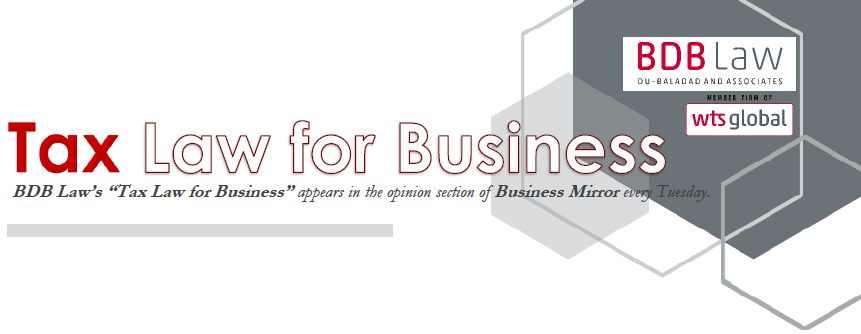
Procedures for the Availment
of Tax Treaty Benefits: Then and Now
By: Atty. Mabel L. Buted
"The BIR does not accept the application if the documentary requirements are not complete. Now, when, on its face and based on the checklist, the documents are not complete, the BIR rejects the filing.
So, with the issuance of the new guidelines, taxpayers are advised to ensure the completeness of these requirements upon filing, and to explain at the first instance that some of the documentary requirements are not applicable, otherwise, there is a risk that the filing will not be accepted."
Last year, the Bureau of Internal Revenue issued Revenue Memorandum Order (RMO) No. 14-2021, streamlining the procedures for the availment of tax treaty benefits. This RMO updated the guidelines and procedures and supposedly reformat the manner of confirming the entitlement to treaty benefits.
With these objectives, the new RMO gave the income payor-withholding agent the option to apply the tax treaty rate/exemption outright, so long as the non-resident foreign payee provides to the payor its Tax Residency Certificate and BIR Form No. 0901 (Application Form) prior to the payment for the first time of the income involved in the transaction. To that extent, the Bureau may have achieved its intention. With the new RMO, the taxpayer is permitted to enjoy the tax treaty benefit even without a prior tax treaty relief application (TTRA).
However, there are still many things to be done before a taxpayer could fully enjoy the tax treaty benefits.
Taxpayers (both the payor and the income recipient) are still not spared from the requirement of filing a subsequent application. Either the payor-withholding agent or the non-resident foreign payee is required to file a subsequent application in the form of a request for confirmation of tax treaty benefit entitlement or a TTRA. The form of the application and the determination of the proper party to file the application must be the reason why, in the RMO, the withholding tax return and the alphabetical list of payees became part of the filing requirements. These two were not required based on the rules existing prior to RMO No. 14-2021.
Also, bank documents or certificate of deposit and other proofs of payments or remittances of the income are required to be submitted. These were not required before. And in some instances, the invoices duly issued by the income recipient and proofs that the payment of income is not effectively connected with the permanent establishment of the foreign enterprise also need to be submitted.
For income constituting business profits, the contract executed by the parties is not even sufficient based on the new rules, as the authorization of the signatories to the contract to sign is also being required. In addition, a Certificate of Completion of the project needs to be executed and submitted.
For interests, dividends and royalties, the submission of the simpler Certificate of Residence for Treaty Relief (CORTT) previously mandated under RMO No. 8-2017 was replaced. Aside from resurrecting the previous requirements of RMO No. 72-2010, the following need also to be submitted: (a) for interest, proof that the interest rate is at arm’s length, if the debtor and creditor are related parties; and (b) for dividends, certified true copy of the Audited Financial Statements (“AFS”) as of the last fiscal year, and the General Information Sheet (“GIS”) for the year immediately preceding the date of declaration.
Before, the filing of TTRA is mostly done on a per contract or transaction basis. This was changed. For long-term contracts involving the payment of income where the condition for entitlement to treaty benefits is dependent on time threshold, like service income, an annual updating is mandatory.
Apparently, the new guidelines imposed additional requirements, some of which are superfluous or redundant, if not impractical, in the determination as to whether or not the taxpayer has met the conditions prescribed under the treaty to be entitled to the tax benefits.
I’d like to note that at the time of filing for confirmation or TTRA, the income may just have been accrued and not have been paid yet. In these instances, some of the requirements are not applicable. There could therefore be no proof of payment nor certificate of completion to be submitted. Yet the application is not accepted in the absence of such requirement.
Also, the mandatory submission of the authorization of the representatives to sign the contract does not have anything to do with the determination of the entitlement to treaty benefits. If there is already a transaction, then there is a business between the parties. The authority of the signatory is irrelevant in the applicability of the treaty rules.
Likewise, the fact that the interest rate involved is at arm’s length or not is irrelevant, as the value of the interest is not a factor in the enjoyment of tax treaty relief on interest payments. Why is there a need then to show proof that the interest rate between the parties is at arm’s length or not? That arm’s length rate, perhaps, is a subject of an audit but not in the determination of the entitlement to treaty benefits. For dividends, the information sought to be obtained from the AFS or the GIS may already be found in the Board Resolution or the Certification from the Corporate Secretary already submitted as part of the application.
The BIR does not accept the application if the documentary requirements are not complete. This is a complete deviation from the procedures before. Prior to RMO 14-2021, applications were accepted and assigned a Control Number upon filing, with Notice to Submit Documents, in case there are lacking documents or there is an additional request of documents noted during the evaluation of the application. Now, when, on its face and based on the checklist, the documents are not complete, the BIR rejects the filing.
So, with the issuance of the new guidelines, taxpayers are advised to ensure the completeness of these requirements upon filing, and to explain at the first instance that some of the documentary requirements are not applicable, otherwise, there is a risk that the filing will not be accepted.
Almost a year has passed since the implementation of the new RMO. I can imagine the experiences of taxpayers. Was the Bureau’s objective of streamlining the procedures for treaty availments achieved or was the process made more difficult?
The author is a junior partner of Du-Baladad and Associates Law Offices (BDB Law), a member-firm of WTS Global.
The article is for general information only and is not intended, nor should be construed as a substitute for tax, legal or financial advice on any specific matter. Applicability of this article to any actual or particular tax or legal issue should be supported therefore by a professional study or advice. If you have any comments or questions concerning the article, you may e-mail the author at This email address is being protected from spambots. You need JavaScript enabled to view it. or call 8403-2001 local 312.



